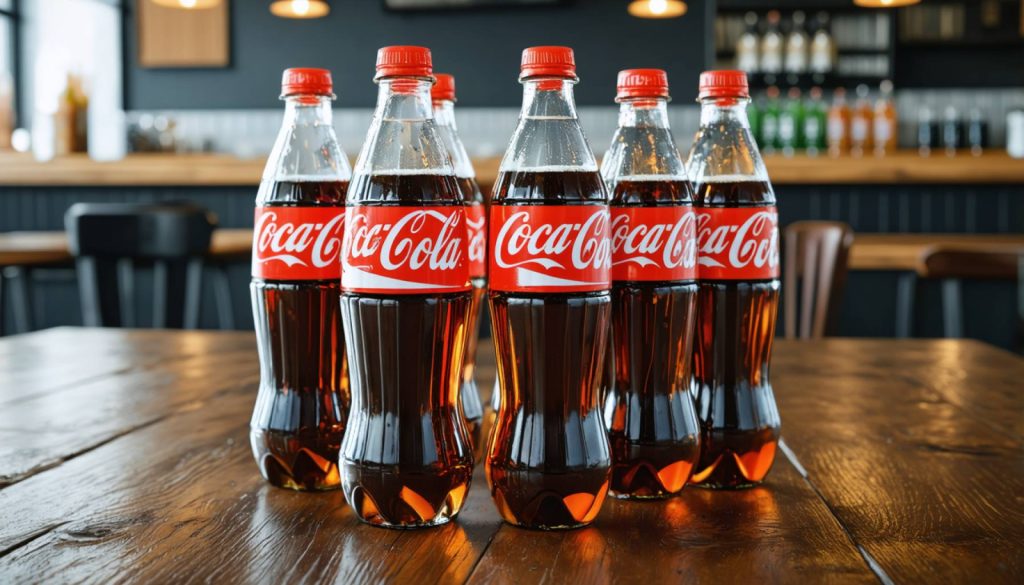
- Coca-Cola is investing $1.4 billion to enhance production infrastructure in Argentina, demonstrating its commitment to evolution in the beverage industry.
- The company is diversifying beyond carbonated drinks, expanding into bottled water, energy drinks, and coffee with the acquisition of Costa Coffee.
- Embracing reduced-sugar juices and fortified beverages in Europe and the Middle East, Coca-Cola is aligning products with health-conscious consumer preferences.
- Hyper-localization efforts ensure Coca-Cola integrates into local markets, enhancing brand loyalty with regional favorites like Thums Up in India and Inca Kola in Peru.
- Leveraging AI and data analytics, Coca-Cola tailors market strategies and strengthens direct-to-consumer channels for innovative consumer engagement.
- Consistent dividend payouts attract investors, with Wall Street maintaining a strong “Buy” consensus on Coca-Cola’s future.
Picture the vibrant clink of glass on glass, red labels glistening under the sun—a moment captured in time by the unmistakable presence of Coca-Cola, a brand synonymous with refreshment across the globe. Yet, beyond the iconic imagery and its century-spanning footprint, Coca-Cola is not merely quenching thirsts; it’s scripting a new chapter in its enduring legacy as a market leader.
In 2025, the company lauded not just for its classic cola but for its strategic ventures, stands as a testament to evolution in the beverage industry. The juggernaut is making significant waves with a $1.4 billion investment to bolster production infrastructure in Argentina—a country once emblematic of South American potential now reaffirmed through Coca-Cola’s commitment.
Beyond the Fizz: Diversification for Dominance
While carbonated beverages are its cornerstone, Coca-Cola’s foray into non-carbonated drinks paints a dynamic portrait of diversification. From bottled water to energy drinks, Coca-Cola is redefining its portfolio. A pivotal acquisition of Costa Coffee underscores its strategic pivot towards caffeine aficionados, tapping into a market expected to grow substantially over the next decade.
The diversification doesn’t stop there. In embracing alternative beverages, Coca-Cola has introduced reduced-sugar juices and fortified beverages in regions like Europe and the Middle East. By leveraging consumer analytics powered by data and artificial intelligence, the beverage behemoth is fine-tuning its offerings to align with shifting consumer preferences—turning data acumen into a competitive advantage.
Local Touch, Global Impact
Coca-Cola’s journey across international borders is anything but mere expansion. It’s an astute embrace of hyper-localization, weaving itself into the cultural fabric of each market it touches, from the robust flavors of Thums Up in India to the beloved Inca Kola in Peru. This personalized approach deepens brand loyalty and ensures that Coca-Cola isn’t just a global brand but a local favorite wherever it reaches.
Embracing Technology and Innovation
In a surprising twist for a beverage company, Coca-Cola is leveraging cutting-edge technology to stay relevant. AI tools glean insights into consumer habits, enabling precise market strategies that are both innovative and informed. The company’s direct-to-consumer channels not only offer convenience but also serve as a rich data source, reshaping how Coca-Cola approaches market trends and consumer desires.
A Toast to the Future with Dividends
Despite the vicissitudes of the market, Coca-Cola continues to entice investors with its steadfast dividend payouts. The allure of passive income, fueled by Coca-Cola’s reliable dividend growth, cements its status as an attractive choice for both seasoned and new investors. The sentiment on Wall Street reflects this, with a strong “Buy” consensus, painting a picture of confidence in Coca-Cola’s future trajectory.
As the world turns its gaze toward the unpredictable climate of global markets, Coca-Cola stands undeterred, fueling its journey not just with erythrosin-red bubbles but with smart investments, strategic diversification, and a robust embrace of technology. The message is clear: Coca-Cola is not just riding the wave but creating it, ensuring its place at the forefront of the beverage industry for years to come.
Coca-Cola’s Bold Strategy: Transforming the Beverage Industry and Beyond
Introduction: Coca-Cola’s Legacy and Future Ventures
Coca-Cola, a symbol of refreshment worldwide, is rewriting its narrative beyond its traditional beverages. With strategic investments, technological advancements, and diversification into non-carbonated beverages, the company is poised to retain its industry leadership well into the future.
Diversification: More Than Just Soda
Coca-Cola’s expansion into non-carbonated segments like bottled water and energy drinks has diversified its product range. Notable acquisitions, such as Costa Coffee, highlight its strategic repositioning in the growing global coffee market. This move aligns with market forecasts that anticipate significant growth in coffee consumption over the next decade. Coca-Cola’s reduced-sugar juice offerings and fortified beverages in Europe and the Middle East cater to health-conscious consumers, a demographic who are increasingly driving market demand.
How to Leverage Coca-Cola’s Product Range
1. Mix and Match: Create a variety of drinks by blending Coca-Cola products. For instance, pairing Costa Coffee with Schweppes Tonic for a unique twist.
2. Health-Conscious Choices: Opt for Coca-Cola’s fortified beverages and reduced-sugar juices as part of a balanced diet.
Local Adaptation: Tapping into Markets Globally
Coca-Cola’s strategy of hyper-localization makes it a beloved local brand across numerous countries. By integrating products like Thums Up in India and Inca Kola in Peru into its portfolio, Coca-Cola preserves cultural relevance while maintaining global brand strength. This approach, along with purposely designed beverage variants, helps solidify its place in culturally diverse markets.
Technological Innovation: Leading with Data
Coca-Cola’s use of cutting-edge AI tools empowers it to fine-tune its offerings and understand consumer preferences with unprecedented precision. This use of data insights allows for tailored marketing strategies that resonate with local and global audiences alike.
Investment Insights: Why Coca-Cola Remains a Strong Portfolio Choice
Coca-Cola has a history of reliable dividend payouts, making it an attractive investment option. Analysts consistently maintain a strong “Buy” rating, reflecting confidence in the company’s continued profitability and growth.
Pros and Cons Overview
– Pros:
– Diverse product portfolio caters to changing consumer preferences.
– Strong brand recognition and loyalty.
– Robust financial performance and attractive dividends.
– Cons:
– Competition from healthier beverage alternatives.
– Economic vulnerabilities in emerging markets.
– Environmental concerns regarding beverage packaging.
Real-World Use Cases and Market Forecasts
– Coca-Cola’s Costa Coffee acquisition allows leverage in high-growth markets like Asia, fueling expansion with multiple franchise opportunities.
– In the energy drink sector, Coca-Cola’s partnerships are expected to capture a larger market share by introducing innovative products that appeal to younger audiences.
Conclusion: Actionable Recommendations
1. Investment Tip: Consider Coca-Cola for long-term portfolio diversification, focusing on its reliable dividends and global market strategy.
2. Consumer Advice: Explore the varied range of Coca-Cola products, including the growing selection of health-conscious options.
To stay informed on the latest from Coca-Cola, visit their official site for more updates, Coca-Cola.
With strategic investments, innovative product offerings, and a commitment to sustainability, Coca-Cola is not just quenching thirsts but redefining its presence as a leader in the beverage industry.



